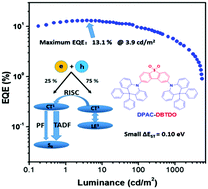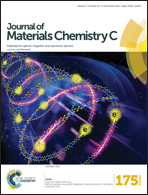Highly efficient organic light emitting diodes based on a D–A–D type dibenzothiophene derivative exhibiting thermally activated delayed fluorescence with small ΔEST†
Abstract
A new D–A–D type TADF material, namely DPAC–DBTDO, is constructed using 9,9-diphenyl-9,10-dihydroacridine as an electron donor and dibenzo[b,d]thiophene-5,5-dioxide as an electron acceptor. DPAC–DBTDO possesses a very small ΔEST of 0.10 eV between S1 and T1, which is the lowest value among DBTDO-derivatives. DPAC–DBTDO exhibits nearly 100% solid-state efficiency. A high external quantum efficiency of 13.1% is also achieved in multi-layered OLEDs.


 Please wait while we load your content...
Please wait while we load your content...